What Muscles Does Hang Clean Work And Why It Matters?
Author:
Unlock your full potential by engaging with our experts and community! Have questions about your fitness journey or looking for expert advice on weightlifting techniques? Don’t hesitate — leave a comment below and Oleksiy Torokhtiy will provide a personalized answer and insights to help you reach your goals.
Torokhtiy is reader-supported. Some links are affiliate links, and we may earn a commission at no extra cost to you. See our disclosure page for details.
The hang clean is the cornerstone exercise in Olympic weightlifting, functional fitness and athletic training. It’s known for its ability to build explosive power, strength and coordination.
But what makes the hang clean so effective is its engagement of multiple muscle groups, from your legs to your upper back in one fluid movement.?
What muscles does hang clean work? – This drill primarily targets the quads, hamstrings, glutes, traps, delts and calves. It also engages secondary muscles, like biceps, forearms, lats and core. This full body movement builds explosive strength, coordination, making it a staple for weightlifters, athletes and fitness enthusiasts.
Whether you are aiming to improve your Olympic lifts, develop functional strength for every day or enhance your performance in sports, understanding what muscles does hang clean work can help you make more informed decision during exercise selection.
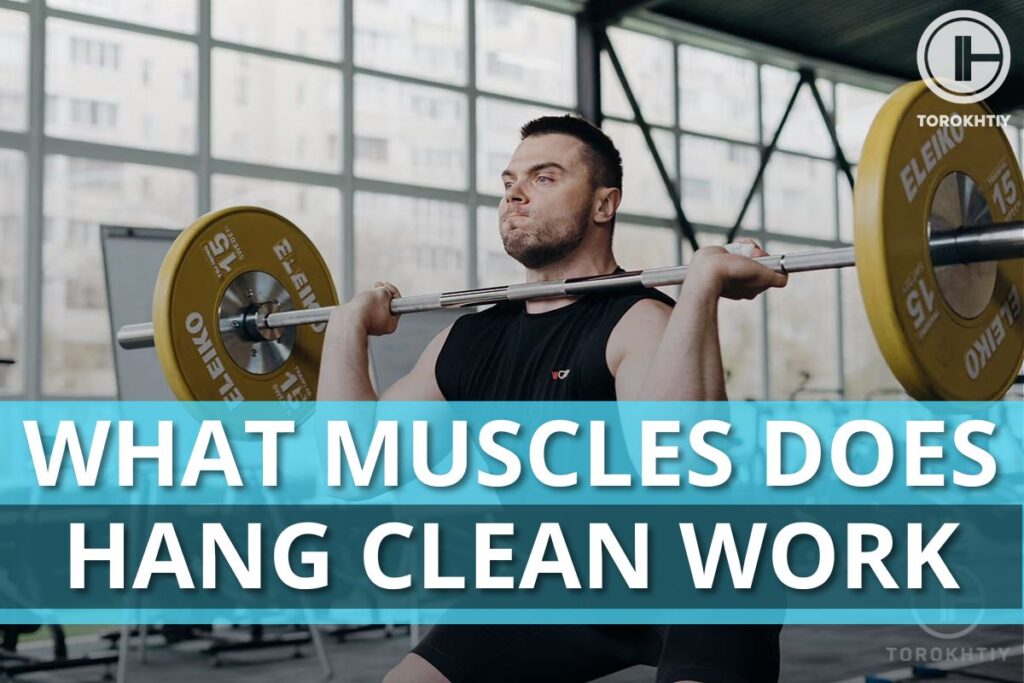
In this article, we will break down the muscles worked by the hang clean, helping you optimize your training and get the most of this powerful lift.
Ready to understand why the hang clean is such a game changer for building explosive strength and power? Let’s dive in!
Primary Hang Clean Muscles Worked
1. Quadriceps (Front Thighs)
The quads are responsible for knee extension during the explosive portion of the hang clean. As you lower into the hang position, your quads are controlling the degree of knee flexion. This muscle group is essential for generating the power during the second pull and full extension phases needed to move the bar quickly.
2. Hamstrings and Glutes
The posterior chain, especially the hamstrings and glutes is heavily involved in the hang clean. These muscles are crucial for hip extension, which occurs during the second pull. A powerful hip drive translates to a strong and efficient clean, helping you lift more weight with better control.
3. Trapezius (Upper Back)
Your traps are key to the stable catch during the clean. As you perform full extension your traps engage to stabilize the upper back before the catch. Strong traps improve overall stability during the movement.
4. Deltoids (Shoulders)
While the shoulders aren’t the primary movers, they stabilize the bar during the catch phase. Once you receive the bar in the front rack position, your delts work hard to stabilize the bar and keep your upper body in control.
5. Calves (Gastrocnemius & Soleus)
Your calves may not be the most noticeable muscle group during the hang clean, but they are crucial for a balance control required for the jump. As you extend through your hips, your calves help complete the lift by contributing to the final push.
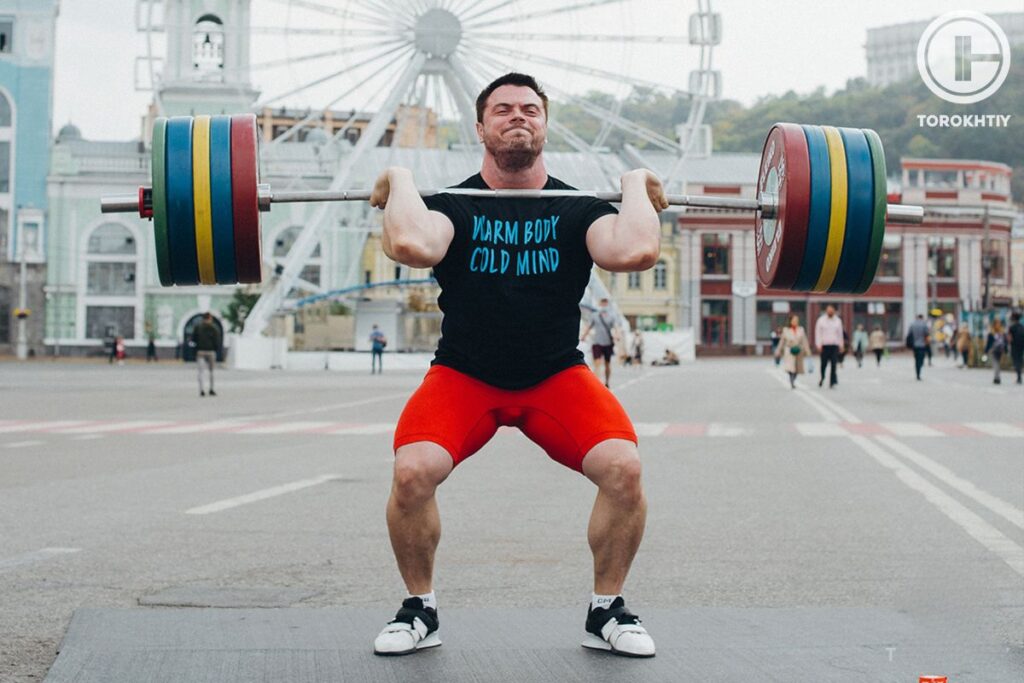
Secondary Muscles Activated
1. Biceps & Forearms
Although the hang clean isn’t an arm dominant movement, your biceps and forearms are engaged as you maintain a strong hookgrip and guide the bar. They help control the bar`s movement and assist in stabilizing it throughout the clean.
At the same time, it is important to control straight arm position during the first and second pull to avoid early arm bend. Tight arms are the biggest enemy for the efficient bar acceleration.
2. Core (Abdominal & Lower Back)
Your core is essential for maintaining balance and stability during the entire lift. A strong core helps stabilize your torso, enabling a better transfer of power from your legs to the bar.
In some way, a static strong core is a bridge between dynamic and explosive legs and the bar in all weightlifting exercises. Without a solid core, you would struggle to maintain form and efficiency.
3. Lats (Latissimus Dorsi)
Your lats play a critical role in pulling the bar close to your body. A straight bar path is key for an effective clean, and your lats are what keep the bar close and controlled as your transition through the lift.
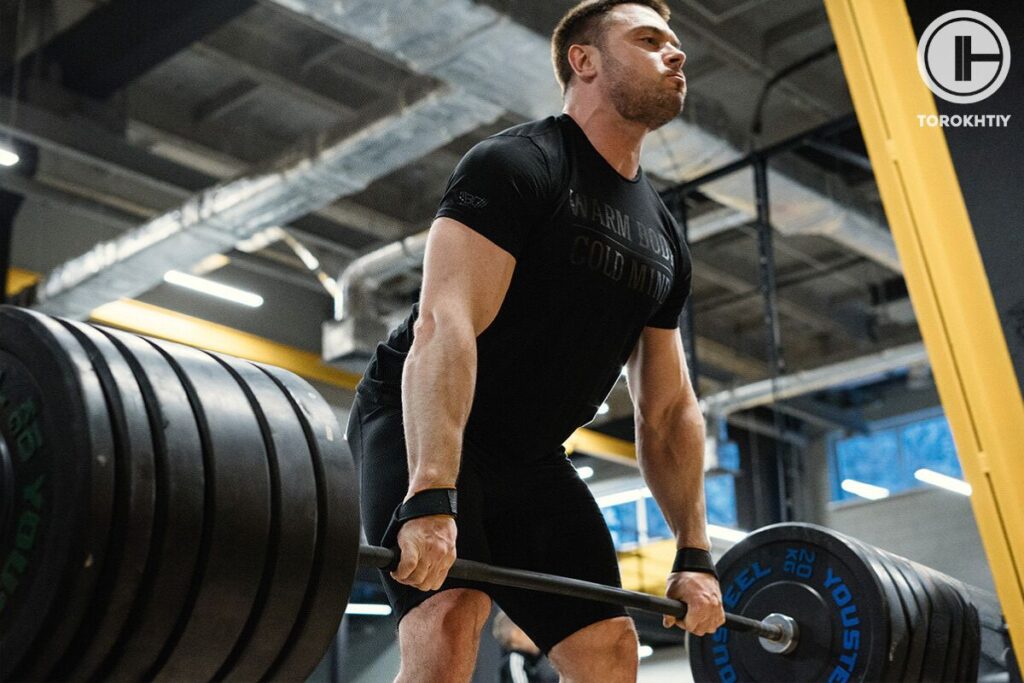
How Hang Clean Benefits Muscle Development?
✅ Full Body Impact
The hang clean is a full body lift that improves strength, power and coordination across various muscle groups. It’s an efficient way to train multiple areas of your body in one movement making it highly beneficial for athletes and weightlifters alike.
✅ Power Development
The explosive nature of hang clean develops fast-twitch muscle fibers, which are essential for power production. This exercise may increase muscle mass in your legs, hips and upper body, enhancing both strength and speed. It’s not just about adding weight on the bar – properly executed hang cleans will increase muscle definition and improve overall athleticism.
Save it for easy access!
Bookmark this page now to access the program and instructional videos anytime, anywhere.
Stop wasting time searching during your gym sessions.
✅ TUT
It is important to mention some very specific particularities of hang exercise. Due to work from the hang position, the TUT (time under tension) will be definitely higher, than in regular clean – meaning the intensity of the work may be also higher. You must keep this in mind, while putting this exercise in your personal or your lifter training plan.
✅ Eccentric Phase
Hang position will increase not only TUT, but also will force you to spend additional time in eccentric and isometric phases compared to regular clean. Athletes don’t really start from the ground, they deadlift the barbell and then slowly lower their bodies to the hang starting position: during this phase leg muscles (quads, hamstrings, glutes) will stretch and get additional eccentric load and stress.
Follow us!

Free!
Get a 2-week Weightlifting Program as a bonus for the subscription to kickstart your training plan!

Free!
✅ Neuromuscular Coordination
The hang clean also improves neuromuscular coordination, which is crucial for the timing, rhythm and efficient lift overall. This coordination transfers to other lifts and sports, making the hang clean a valuable tool for developing total body, strength, and agility.
Motor pattern of explosive hip extension from hang clean can carryover to many other sports.
Also, this exercise may require more time for recovery due to higher impact on muscle and neural system so be sure you monitor your not only muscular but systemic fatigue (due to axial load).
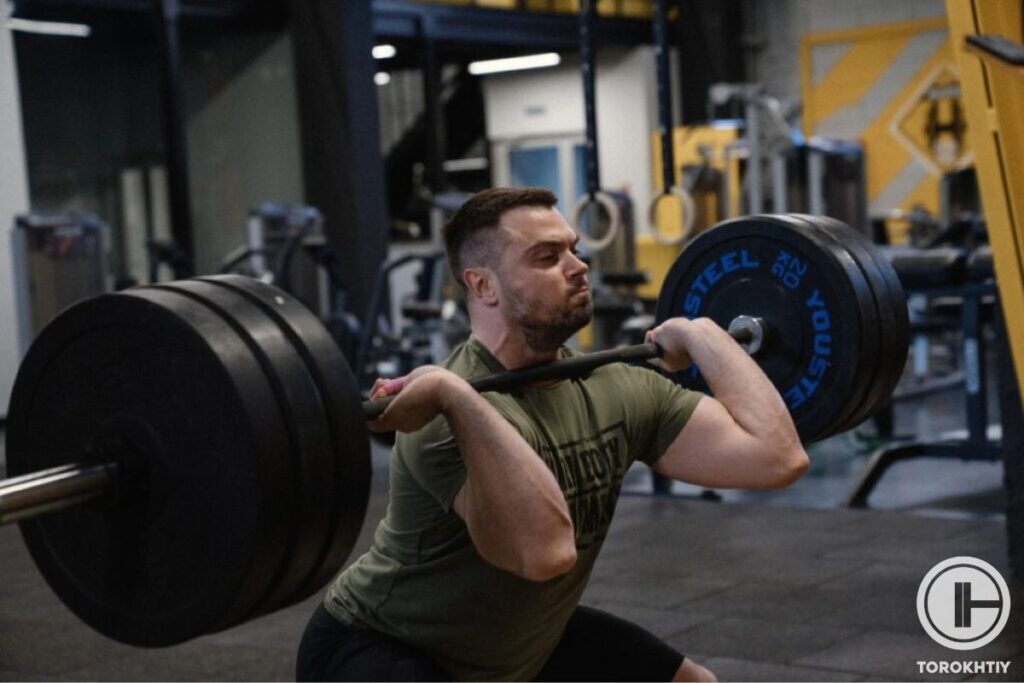
6 Hang Clean Variations & Muscle Focus
1. Hang Power Clean
The hang power clean shifts the focus more toward your traps, shoulders and upper back by catching the bar in a higher position. This variation demands more upper-body strength and improves your ability to generate force quickly.
2. Hang High Clean Pull
The hang clean pull is an excellent variation for targeting the traps and upper back. It helps build the upper body pulling strength needed for an efficient clean.
3. Clean + Hang Clean Complex
In this complex, you perform initial rep as a regular clean and then make all the rest from the hang position.
4. Clean Pull + Hang Clean Complex
Good variation with focus on strength endurance with primary legs and back fatigue and the cleaning from the hang.
5. Hang Clean + Front Squat Complex
This sequence is a common guest in the functional fitness WODs and competitions. After performing 2-3 reps of the Hang Clean lifter continue to front squat in unbroken mode – very challenging stuff.
6. Hang Clean + Jerk Variations Complex
Depending on the goals and the planned intensity – it can be a regular Split Jerk or Push Jerk or even Push Press if the working weight in the bar is relatively low.
Depending on the goal, you can also set different hang position:
- just off the platform;
- below the knee;
- above the knee;
Each position will push you to emphasize a bit different technical sides of the clean.
Each variation of the hang clean has a slightly different muscle focus, so rotating them into your routine ensures well-rounded muscle development.
If your goal is to work with heavier weights or to focus more on the technical side of the movement, it is recommended you use weightlifting straps. On the other hand, if there is a task to make this load more functional and exhausting it makes sense to lift using just a hookgrip. But be ready to feel your palms burning and hands sore for the next couple of days!
4 Common Mistakes and Muscle Engagement Issues
❌ Poor Hip Drive
A lack of proper hip drive can prevent full engagement of the glutes and hamstrings, weakening the second pull. Focus on full vertical body extension, ensuring your posterior chain is fully activated.
❌ Using Too Much Arm Pull
A common mistake is relying too much on your arms instead of your legs. The arms should be guides, not the primary drivers of the lift. Focus on relaxing your arms and engaging your legs for power. Leave your arms to control the path and perform fast elbows rotation during turnover and catch phases.
❌ Not Engaging the Core
Without proper core engagement, you will struggle to maintain balance and stability. This can lead to poor form and even injury. Prioritize keeping your core tight throughout the lift, ensuring that your abs and lower back stay strong and engaged.
❌ Inconsistent Bar Path
An inconsistent bar path means less efficiency, and less power transferred from your legs and back. Make sure the bar stays close to your body throughout the lift, using your lats to keep it under control.
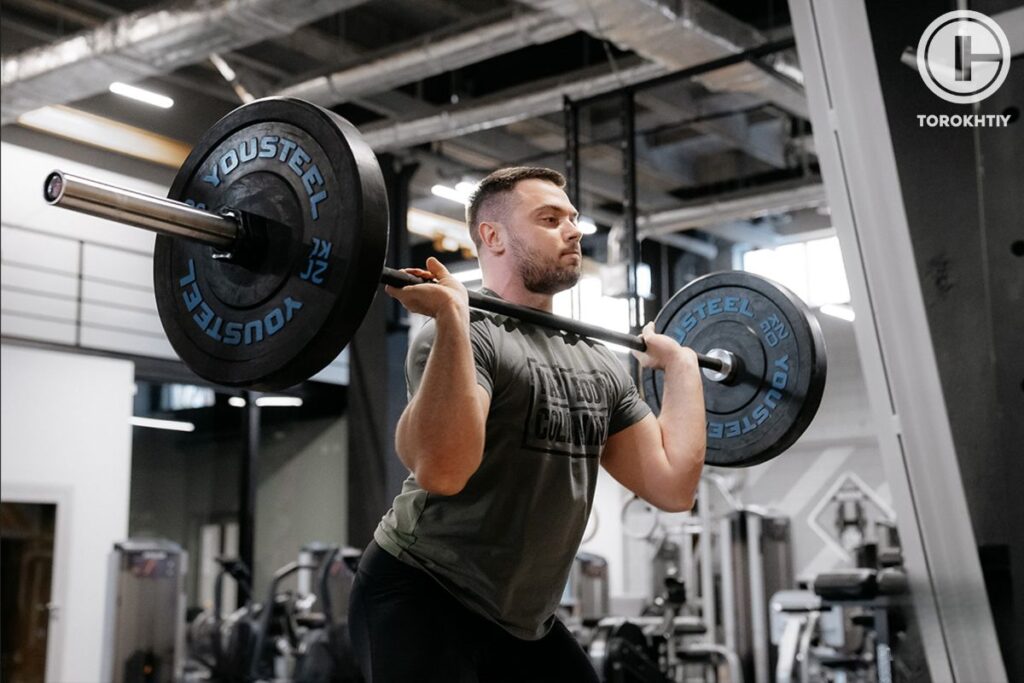
Conclusion
The hang clean is a powerhouse of lift that targets major muscle groups across your body. From your quads and glutes to your traps and delts, every part of your body works in harmony to complete this explosive movement.
Whether you are training for Olympic weightlifting, functional fitness or general strength, understanding what do hang cleans work will help you maximize your results.
Incorporating hang cleans into your routine is a surefire way to build power, coordination and even muscle mass. Give it a go, focus on engaging the right muscles and watch your performance skyrocket.
Did I miss anything? Leave your comment and let’s talk.
References:
- Helland C, Hole E, Iversen E, Olsson MC, Seynnes O, Solberg PA, Paulsen G. Training Strategies to Improve Muscle Power: Is Olympic-style Weightlifting Relevant? Med Sci Sports Exerc. 2017 Apr;49(4):736-745. doi: 10.1249/MSS.0000000000001145. PMID: 27820725.
- Geisler S, Havers T, Isenmann E, Schulze J, Lourens LK, Nowak J, Held S, Haff GG. Effects of Expertise on Muscle Activity during the Hang Power Clean and Hang Power Snatch Compared to Snatch and Clean Pulls – An Explorative Analysis. J Sports Sci Med. 2023 Dec 1;22(4):778-789. doi: 10.52082/jssm.2023.778. PMID: 38045750; PMCID: PMC10690512.
- Kipp K, Malloy PJ, Smith JC, Giordanelli MD, Kiely MT, Geiser CF, Suchomel TJ. Mechanical Demands of the Hang Power Clean and Jump Shrug: A Joint-Level Perspective. J Strength Cond Res. 2018 Feb;32(2):466-474. doi: 10.1519/JSC.0000000000001636. PMID: 27669182.
- Takei S, Hirayama K, Okada J. Comparison of the Power Output Between the Hang Power Clean and Hang High Pull Across a Wide Range of Loads in Weightlifters. J Strength Cond Res. 2021 Feb 1;35(Suppl 1):S84-S88. doi: 10.1519/JSC.0000000000003569. PMID: 32149888.
- Szafraniec R, Bartkowski J, Kawczyński A. Effects of Short-Term Core Stability Training on Dynamic Balance and Trunk Muscle Endurance in Novice Olympic Weightlifters. J Hum Kinet. 2020 Aug 31;74:43-50. doi: 10.2478/hukin-2020-0012. PMID: 33312274; PMCID: PMC7706638.
- Dinsdale AJ, Bissas A. Eliciting Postactivation Potentiation With Hang Cleans Depends on the Recovery Duration and the Individual’s 1 Repetition Maximum Strength. J Strength Cond Res. 2021 Jul 1;35(7):1817-1824. doi: 10.1519/JSC.0000000000003085. PMID: 30844992.
- Photos by Torokhtiy Media Team.
Why Trust Us?
With over 20 years in Olympic weightlifting, strength training, nutrition coaching, and general fitness our team does its best to provide the audience with ultimate support and meet the needs and requirements of advanced athletes and professional lifters, as well as people who strive to open new opportunities and develop their physical capabilities with us.
By trusting the recommendations of our certified experts in coaching, nutrition, and sports training programming, as well as scientific consultants, and physiotherapists, we provide you with thorough, well-considered, and scientifically proven content. All the information given in the articles concerning workout programming, separate exercises, and athletic performance, in general, is based on verified data.
The product testing process is described in more detail here.
Author: Oleksiy Torokhtiy
Olympic Weightlifting Champion
Best Results: Snatch – 200 kg,
C&J – 240 kg
Oleksiy Torokhtiy is a professional athlete boasting 20 years of experience in Olympic weightlifting. With multiple European and World titles under his belt, he has showcased his prowess in two Olympic Games (Beijing 2008 and London 2012). Upon concluding his illustrious career, Oleksiy dedicated himself to coaching. By 2022, he had conducted over 200 weightlifting seminars worldwide. He is the visionary behind an international sportswear and accessories brand known for its motto, “Warm Body Cold Mind.” Additionally, he is an esteemed author and the creator of a series of training programs and eBooks.



Still have questions after reading our article? Unlock your full potential by engaging with our experts and community! Don’t hesitate — leave a comment below and Oleksiy Torokhtiy will provide a personalized answer and insights to help you reach your goals.